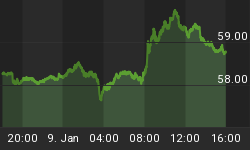Below is an excerpt from a commentary originally posted at www.speculative-investor.com on 5th February 2012.
When reading stuff about the pros and cons of investing in gold we regularly come across two misguided assertions, the first being that changes in gold's price in terms of a currency do little more than offset changes in the currency's purchasing power. To put it another way, the first misguided assertion is that gold's purchasing power is roughly constant over time, meaning that changes in its price are almost solely due to changes in the purchasing power of the money in which the price is denominated.
The following monthly chart of the inflation-adjusted (IA)* US$ gold price disproves the notion that gold's purchasing power (pp) is roughly constant over time. In particular, it is clear from this chart that there was a huge increase in gold's pp during 1971-1980, a huge decrease in gold's pp during 1980-2001, and another huge increase in gold's pp during 2001-2011. It's likely that most of our readers were already aware of these 10-20 year swings in gold's pp, but what is less widely appreciated is that gold's pp is in a much longer-term upward trend. This ultra-long-term trend dates back to the severing of the last official link between the US$ and gold in 1971.
The fact is that an ounce of gold has about eight times more purchasing power today than it did when the final US$-gold link was severed in 1971. Furthermore, even if we make the not-unreasonable assumption that the first major leg of the gold rally of the 1970s was primarily a reaction to the gold price having been pegged at an artificially low level for a couple of decades, we still arrive at the conclusion that gold's pp is in an ultra-long-term upward trend. The reason is that if we take the top of the 1971-1974 rally as our starting point we find that gold's pp more than doubled over the intervening period.

In our opinion, the main reason that gold is in an ultra-long-term upward trend in REAL terms is that the overall cost of monetary inflation (creating money out of nothing) is much greater than the reduction in the purchasing power of money. Monetary inflation can make things look better in the short-term, but it leads to the long-term destruction of wealth. The faster the rate of monetary inflation, the greater the amount of wealth that eventually gets destroyed by misdirected investment.
After the ability of the banking system (the central bank and the commercial banks) to create money out of nothing became unconstrained by gold, the average rate of monetary inflation increased. A long-term effect was slower economic progress (slower rate of improvement in living standards) and heightened desire for more savings in terms of a monetary asset that can't be depreciated at the will of banks and governments.
The other misguided assertion is that owning gold is pointless because gold is a sterile, non-productive asset. This assertion emanates from value investors such as Warren Buffett, who like to compare the total market value of the world's gold with the combined market values of a group of large companies (Wal-Mart, Exxon, Intel, etc.) and pose a question along the lines of: What would you rather own -- a big chunk of metal that does nothing except sit in a vault or all of these phenomenal businesses? The question is meaningless, because nobody is ever faced with the choice of owning the world's gold or owning the 30 best companies in the world.
Most people have a range of investments plus some cash savings. In a world where there was no uncertainty there would be no need to maintain any cash savings, but in the real world there is always uncertainty about the future and therefore the desire -- on the part of most people -- to hold some cash in reserve. Although gold can be a very good investment at times due to the large swings in its pp discussed above, it is the portion of an investor's portfolio dedicated to cash that gold bullion is 'tailor made' to occupy. This means that gold isn't in competition with great companies such as Wal-Mart and Apple, it is in competition with the US$ and the euro and the Yen and the other national currencies.
So, the question that some value investors have asked in their efforts to disparage gold ownership should be re-phrased as:
In which form would you prefer to hold your monetary savings -- in the form of money that banks can create in unlimited amounts out of nothing, or in the form of a metal that has been used as money for thousands of years and whose supply never increases by more than 2% from one year to the next?
The answer to the above question isn't necessarily straightforward. A lot depends on the policies being implemented at the time by central banks and governments. Over the past several years the obvious answer from our perspective has been "the metal", because central banks and governments have been rapidly inflating the supplies of national currencies and generally getting in the way of real economic progress. As things stand today the obvious answer -- again, from our perspective -- is still "the metal", because the Fed is dominated by bozos who truly believe that the economy can be strengthened by counterfeiting money and because the other major central banks are no better.
*Our method of adjusting for inflation was outlined in an article in December of 2010. We make the assumption that over the long term the percentage decrease in the dollar's purchasing power will be approximated by the percentage increase in its supply minus the percentage increase in the combination of population and productivity.
We aren't offering a free trial subscription at this time, but free samples of our work (excerpts from our regular commentaries) can be viewed at: http://www.speculative-investor.com/new/freesamples.html















